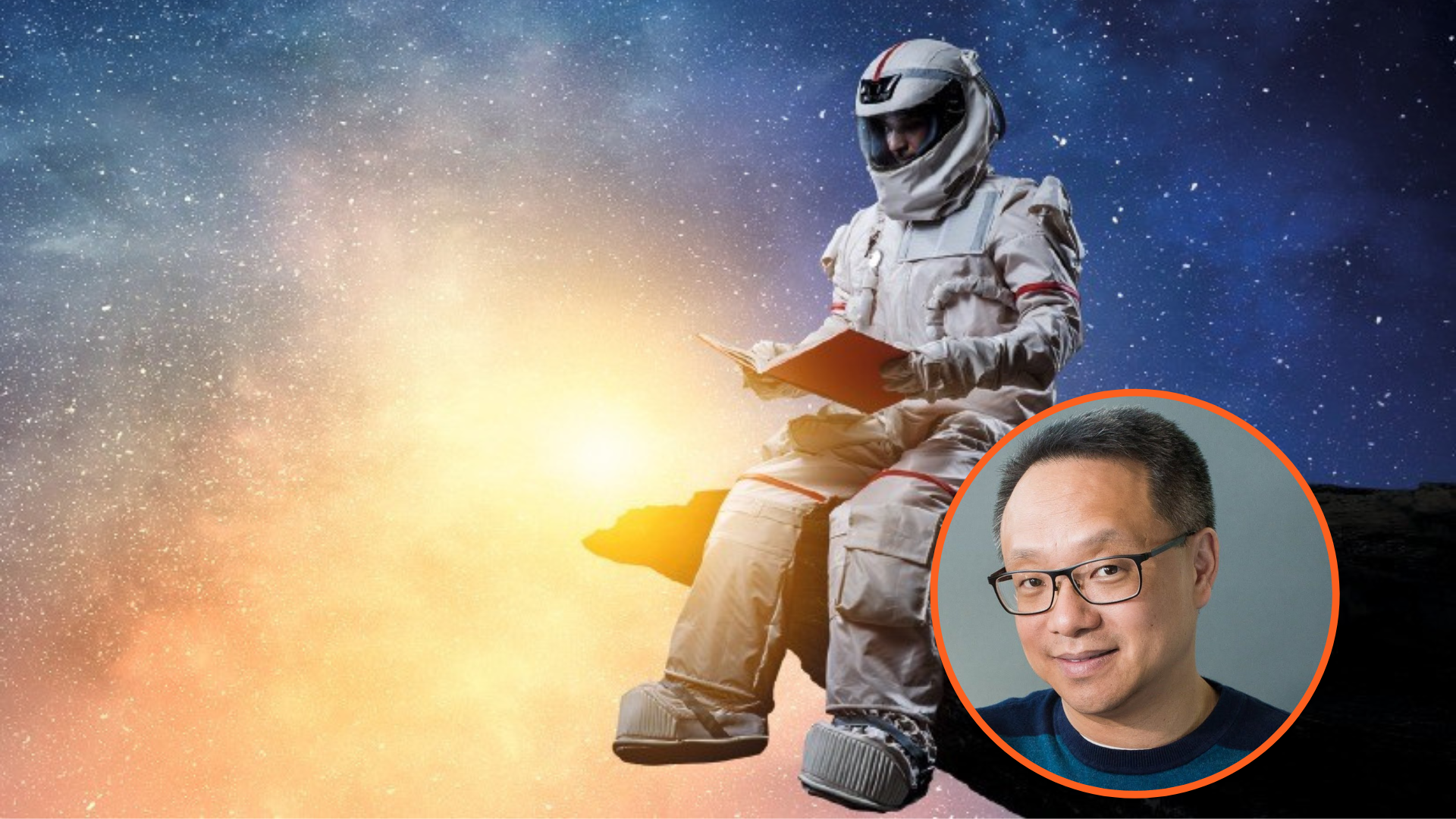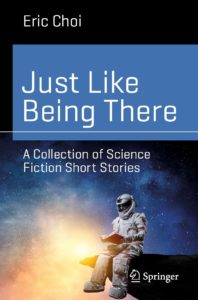
Eric Choi is a licensed professional engineer (P.Eng) with a B.A.Sc in Engineering Science and an M.A.Sc in Aerospace Engineering, both from the University of Toronto, and an MBA from York University. In 2009, he was one of the Top 40 finalists (out of 5,351 applicants) in the Canadian Space Agency’s astronaut recruitment campaign. Just Like Being There is his first collection of science fiction stories, which spans his 25 year writing career.
We talked with Eric about putting together this collection, his writing process, and the beauty of the short story form.
 Just Like Being There brings together 15 of your stories that range from the beginning of your writing career to a new story "A Sky and a Heaven” closing the book. What was it like putting this collection together?
Just Like Being There brings together 15 of your stories that range from the beginning of your writing career to a new story "A Sky and a Heaven” closing the book. What was it like putting this collection together?
Putting the collection together was tremendous fun but also a lot of work. “A Sky and a Heaven” is a novelette and at 15,000 words is the longest story I’ve ever written. For the fourteen other previously published stories, I went back to the manuscripts as I had originally written them and in some cases made minor revisions. For example, I moved out the dates in the story “From a Stone” because as of the publication of the collection humans have not yet resumed crewed voyages beyond low Earth orbit. In general, however, I was pleasantly surprised at how well my stories have held up over time. What actually took the most time and effort was writing the new afterwords that discuss the engineering and science behind the stories. I was fortunate to still have much of the original research material for the stories, but I also did new research to make sure the information was as up-to-date as possible.
Your aerospace engineering background has clearly shaped your writing. Does it flow in the other direction? How have your experiences as an author and editor influenced your work as an engineer?
One of the most important (and enjoyable) aspects of my work as an engineer is public outreach, and in that regard my experiences as a communicator and storyteller have been very important. I also do a lot of proposal writing, which some have argued is another form of science fiction!
In this collection, you share an afterword for each story that discusses the engineering and science behind it. What were your goals in including this explanation?
The title story “Just Like Being There” was first published in a volume of a series called Tales From the Wonder Zone that was created by the biologist and writer Julie Czerneda which uses science fiction to illustrate scientific concepts for elementary school students. Like Julie Czerneda, I believe strongly in the power of science fiction to not only entertain but also to educate, promote critical thinking, and convey a sense of wonder. In the era of pandemics and climate change, science fiction as a tool for science education is more important than ever.
What do you enjoy most about the short story form? What does it bring to science fiction?
The short story is a beautiful literary form because each paragraph or sentence or even word can have so much more impact than they would in a longer work like a novel. For science fiction, it is an ideal format for exploring new ideas. As the American editor and publisher Patrick Nielsen Hayden wrote in his introduction to the anthology Starlight 1: “Short fiction is…the R&D laboratory in which SF [science fiction] constantly reinvents itself. Novels are all very well…but short fiction is where SF writers take chances, stir the pot, kick out the jams. It’s no accident that short fiction has been crucial to each period of major ferment and invention in the modern history of the field. It is, if you will, the garage rock of SF.”
What appeals to you about exploring science-themed alternate histories? What are some of the challenges?
If science fiction is the literature of scientific and technological possibility, then the appeal of science-themed alternate history is in exploring how scientific and technological possibility influences the relationship between chance and determinism in shaping historical events. It is, however, a challenging genre to write. Not only do authors need to get the science right, but they must also recognize the sensitivity of putting real people into fictional situations. Authors of alternate history have an obligation to be careful in their portrayals of real people and ensure that the words and actions of historical figures are consistent with what is known about them from the historical record. For example, the closing story “A Sky and a Heaven” is an alternate history about the Space Shuttle Columbia accident. I changed the name of the commander of Columbia because in an early draft of the story this person did something that I felt was inconsistent with the personality of the real commander Rick Husband.
What is your writing process like? How much research do you do before sitting down to write a story?
Writing is a creative process and there is no right or wrong way to do it. Each writer must find their own process that works for them. Perhaps befitting of my engineering background, my writing process is quite methodical. I start by doing a lot of research. From there, I plan out a preliminary plot with outlines of scenes written on sticky notes, and in parallel I sketch out brief profiles of the major characters. In recent years, I have started keeping spreadsheets to check that character names are sufficiently varied (to avoid reader confusion) and to keep me mindful of diversity and inclusion. Only after I have done this foundational planning will I start to write the first draft. The story plan is not set in stone and I sometimes change the plot and characters as I go, but I will not start writing the story without the plan. For the first draft I write sequentially in the scene order of the plot plan from start to finish, and I do not try to revise anything yet. At this stage, the most important thing for me is simply to produce words. To keep myself honest, I note on a calendar how many pages I have written every day. After I have finished the first draft, I try to have a cooling-off period in which I take a break and not look at the manuscript for at least a few days so that when I revise the story it will be with fresher eyes. Reviewer feedback is absolutely invaluable, so I share the manuscript with some general beta readers as well as people with specialist background relevant to the story. After incorporating their feedback and making the final revisions, I send the story to the publication – and I start thinking about my next story!
Why should people read science fiction?
Science fiction is the literature of possibility, the genre that examines the implications – both beneficial and dangerous – of new sciences and technologies. People should read science fiction because it is not just about what is and what was, but what could be. A compelling science fiction story can take a reader to any point in space and time, from the farthest reaches of the Universe to the depths of the human soul. For people reading science fiction, it really can be just like being there.
What are you reading right now?
A lot of my pleasure reading is non-fiction. I am currently reading Liftoff by Eric Berger which is about the early years of SpaceX. Other books I’ve recently read include Corruptible by Brian Klaas which argues that it is not power that corrupts but corruptible people who are drawn to power, Flying Blind by Peter Robison about the Boeing 737 MAX tragedies, War by Margaret MacMillan which discusses the history of human conflict, and Crisis in the Red Zone by Richard Preston about the 2014 Ebola virus outbreak in West Africa.


